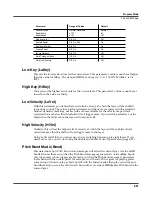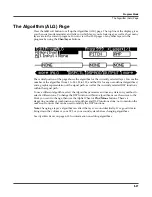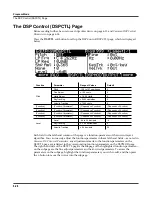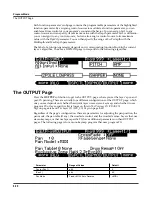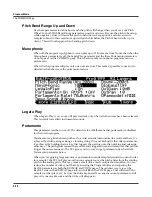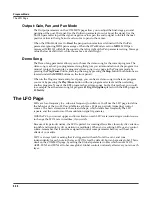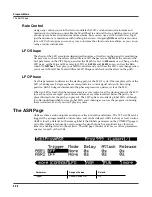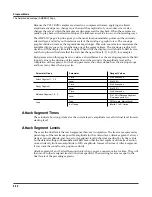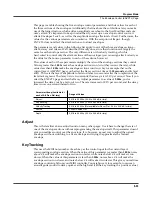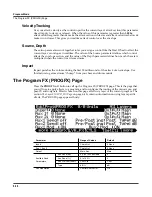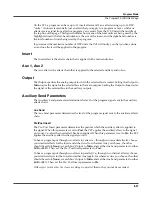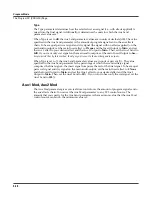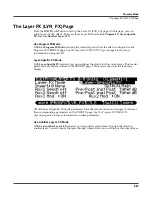
6-36
Program Mode
The LFO Page
Output: Gain, Pan, and Pan Mode
The Output parameters on the COMMON page allow you to adjust the final-stage gain and
panning of the post-FX signal. Use the OutGain parameter to cut or boost the signal. Use the
OutPan parameter to pan the signal; negative values pan the audio signal to the left channel,
positive values to the right, and a value of zero pans to the center.
When the OPanMode is set to
Fixed
the pan position remains as defined with the OutPan
parameter, ignoring MIDI pan messages. When the OPanMode is set to
+MIDI
, MIDI pan
messages (MIDI 10) will shift the sound to the left or right of the Pan parameter setting. Message
values below 64 shift it left, while those above 64 shift it right.
Demo Song
The Demo Song parameter allows you to choose the demo song for the current program. The
demo song is a short, pre-programmed song that gives you a demonstration of the program in a
musical context. You can play a program’s demo song in any page in the Program mode by
pressing the
Play/Pause
button, and stop the song by pressing the
Stop
button (both buttons are
located under the
MODE
buttons on the front panel).
When in the Program mode entry-level page, you can hear a demo song in whatever program
you want by pressing the
Play/Pause
button with one program selected, and then selecting
another program. None of the KB3 programs have demo songs, but by this method, you could,
for example, hear the demo song for program
83 Big Old Jupiter
played with the KB3 program
53 Testify
.
The LFO Page
LFOs are low-frequency (i.e., subsonic frequency) oscillators. You’ll use the LFO page to define
the behavior of the two LFOs available to each layer. LFOs are periodic (repeating) control
sources. The basic elements are the rate and shape, which define how frequently the LFO
repeats, and the waveform of the modulation signal it generates.
With the PC3, you can set upper and lower limits on each LFO’s rate, and assign a control source
to change the LFO’s rate in realtime, if you wish.
Because of its periodic nature, the LFO is perfect for creating effects like vibrato (cyclic variation
in pitch) and tremolo (cyclic variation in amplitude). When you’re editing LFOs, or any control
source, remember that it must be assigned to control some parameter before you’ll hear the
effects of your edits.
LFO1 is always local, meaning that it’s triggered with each Note On event, and runs
independently for each note in the layer. LFO2 is local by default, but can be made global. This is
done on the COMMON page, by setting the Globals parameter to
On
, which causes LFO2,
ASR2, FUN2 and FUN4 all to become global. Global controls uniformly affect every note in each
layer.
Summary of Contents for PC3
Page 24: ...1 6 Introduction Options ...
Page 50: ...4 4 The Operating Modes Using the Modes ...
Page 174: ...7 54 Setup Mode The Utility Soft Buttons ...
Page 178: ...8 4 Quick Access Mode Making Your Own QA Banks ...
Page 204: ...9 26 Effects Mono Algorithms ...
Page 266: ...A 2 MIDI Implementation Chart ...
Page 308: ...Index x ...


